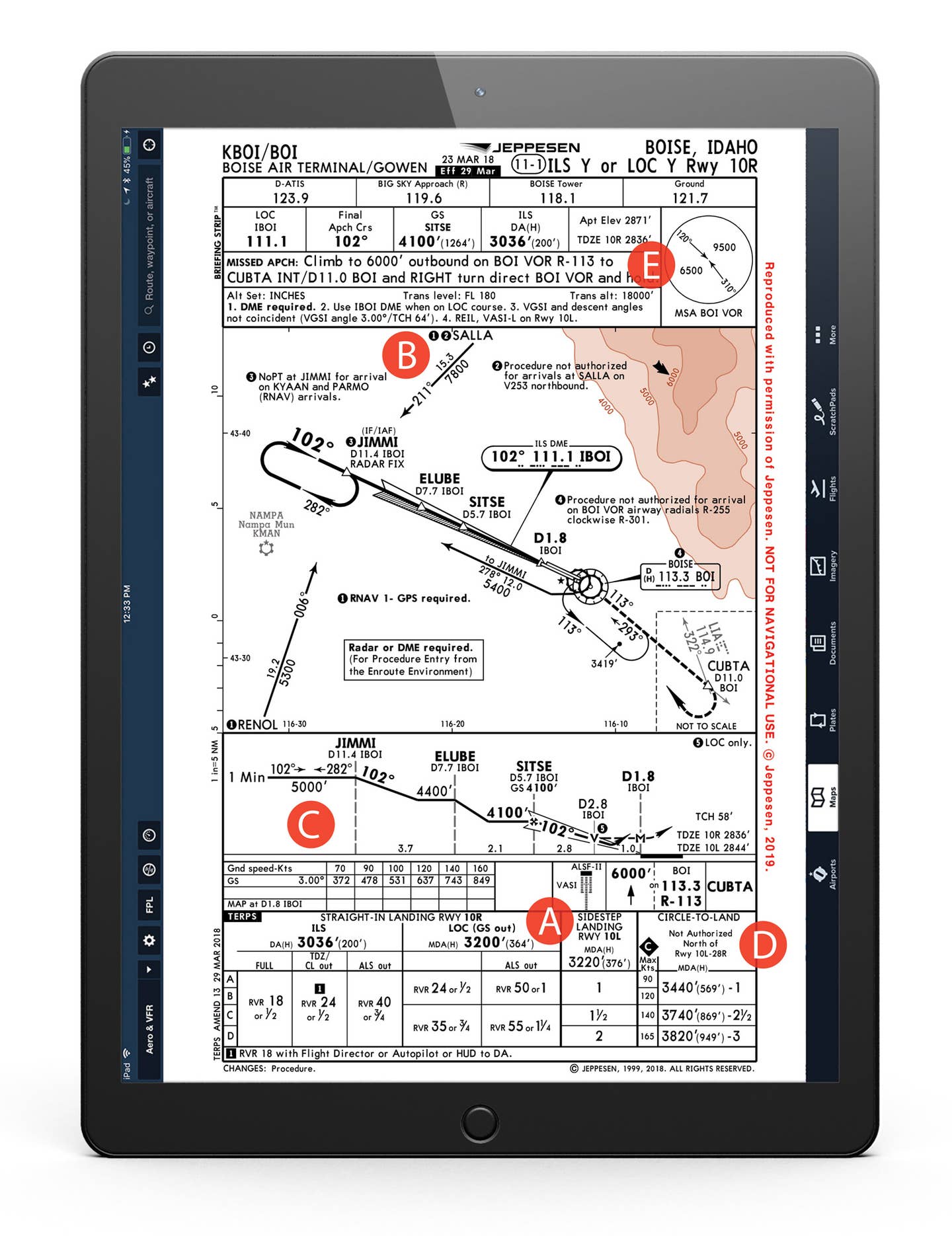
The ILS Y 10R approach into Boise. Jeppesen
With approximately one-third of its annual 128,200 operations traffic count consumed by airline operations and the rest split between air taxi, general aviation and military operations, Boise, Idaho (BOI), demands pilots be on their toes for traffic of all shapes and sizes when visiting. This month’s ILS Y 10 Right approach comes equipped with a number of potential step-down fixes along the way to SITSE, the FAF, as well as the potential for a little maneuvering to the landing runway near the end of the approach and a couple of noted items that might trip up a pilot not paying close attention to the plate.
A. Side Step Minimums
While they don’t appear all that often in IFR flying, sidestep minimums do exist, and they offer a switch from the primary approach runway to a parallel—in this case, 10 Right to 10 Left—once inside the marker. When the weather is good, a sidestep might be issued by ATC or requested by the pilot. Should a pilot flying this approach decide to land on Runway 10 Left, perhaps for traffic or to reduce their after-landing taxi time, they would be subject to an entirely different set of minimums. In the minimums table near the bottom of the plate, the minimums for the full ILS are 3,036 feet. A pilot planning an arrival on Runway 10 Left faces minimums of 3,220 feet (376 feet higher) than when landing on Runway 10 Right.
B. Multiple Feeder Routes
Pilots of aircraft not being vectored to the ILS Y 10 Right procedure can choose a number of “feeder routes” to establish themselves on the inbound track. Denoted by a thick arrow line, three are available on this approach. One begins at RENOL, a second at SALLA and a third from the Boise VOR. Each lead to the JIMMI intersection where a hold or procedure turn can be used to establish an aircraft on the inbound leg. It’s important to pay close attention to the notes attached to each feeder route indicating the conditions under which they’re valid, including a number of different altitudes to JIMMI. For example, aircraft approaching the Boise area northbound on V253 may not use this approach procedure because it would require a complete course reversal from SALLA.
C. Step-downs
Inbound from JIMMI, pilots should be careful because both the BOI VOR and the ILS offer DME. A pilot should be tuned to the ILS frequency 111.1 when using DME outbound on the ILS for a course reversal or when established inbound on the ILS course. A pilot previously using DME from BOI could forget to switch the DME to the localizer frequency, which is important because step-downs at ELUBE and SITSE intersections use the localizer DME. This is enough of a concern because the VOR is not co-located on the airport where the ILS DME is generated, and the notes section at the top of the plate reminds pilots to “use IBOI DME when on LOC course.” Another DME-related point worth noting if flying the approach to LOC, sidestep or circling minimums: In any of these cases, the MAP is not 0.0 DME at the runway threshold but 1.8 DME. Hence pilots should not expect a countdown to “zero” when flying this approach to the MDA missed approach point.
D. Circle South
A note in the circle-to-land minimums indicates that pilots executing this maneuver must remain south of Runway 10 Left-28 Right, no doubt because of the higher terrain to the north and east that climbs to 3,000 feet above the airport elevation.
E. The Missed Approach
The ILS Y 10 Right missed approach asks the pilot to climb to 6,000 feet but not straight ahead. At the missed approach point, pilots must transition from the inbound ILS course to the 113-degree radial of the BOI VOR to the CUBTA intersection formed where the 113 radial intersects the Liberator (LIA) 322 radial. But that’s not all. The pilot must then make a right turn to re-intercept the BOI 113 radial (a 293 course) back to enter the depicted hold at the BOI VOR.
This story appeared in the March 2020 issue of Flying Magazine

Sign-up for newsletters & special offers!
Get the latest FLYING stories & special offers delivered directly to your inbox






